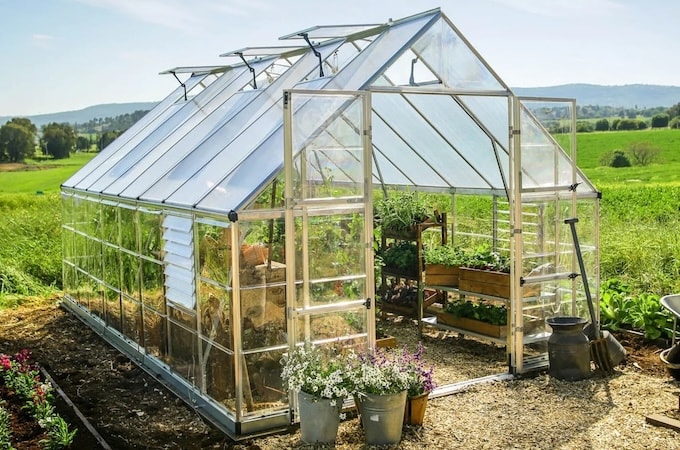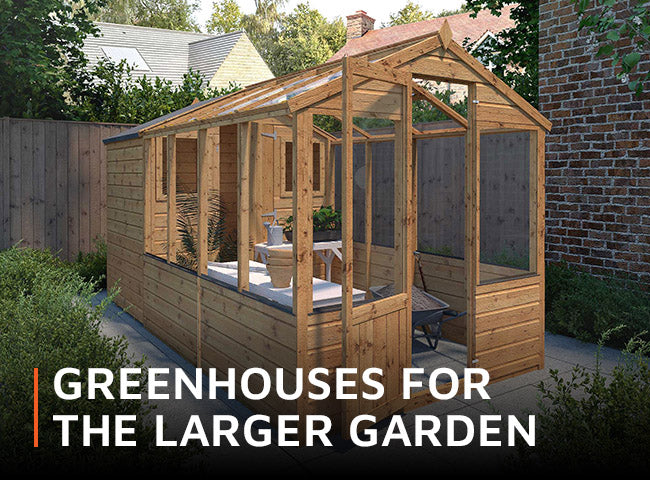Have a large garden and want to get the most out of it all year long? It’s time to invest in a greenhouse.
Greenhouses allow you to grow those plants that need more shelter and warmth than we get in a typical British garden. You’ll be able to stretch the growing season – starting seedlings earlier in spring and growing crops late into the autumn. And with some extra heating, you could even grow a variety of organic vegetables all year round.
Where to start?
If you’re lucky enough to have a lot of outside space, you’ll have plenty of choice when it comes to garden greenhouses. But where to start? With models costing a few hundred to several thousand pounds, how do you decide which will best suit you?
In the end it all comes down to how much space you have and the size of your budget. No serious gardener ever complained about their greenhouse being too large, so go for the biggest one you can afford.
This means that the very first step in choosing your new greenhouse has to be choosing the right location, so that you know how much space you have to play with.
Where to put your greenhouse?

Image: Waltons 6x6 Evesham Greenhouse (Customer image)
Siting is the most important decision you’ll make about your new greenhouse. Get that right, and you’ll enjoy untold benefits from greenhouse growing.
Luckily, larger gardens offer a range of locations, and all the greenhouses in the Waltons range can be professionally installed by our expert team. Study the requirements below to find the optimum greenhouse site for your garden.
1) Light

Image: Canopia by Palram Harmony 6 x 6 Silver Greenhouse from Waltons
Your greenhouse needs as much light as possible. Think about orientation as well as the position. For year-round growing, have the roof ridge running from east to west, as this will give maximum sunlight during the winter months. For summer-only growers, orient your greenhouse on the north-south axis to equally distribute the summer sun and prevent overheating on hotter days.
Don’t site your greenhouse underneath trees. The trees will cast shade on your greenhouse, encouraging green algae to grow. Fallen leaves and branches will also block guttering, while honeydew from insects will make the glass sticky.
2) Shelter
Although you don’t want your greenhouse directly underneath trees, a sheltered spot by hedges or fences can protect your greenhouse from damage and extreme temperature fluctuations caused by northerly and easterly winds.
3) Level ground
Level ground is essential. Building your greenhouse on a slope will be nigh on impossible. And never site a greenhouse at the base of a slope – cold air accumulates here, dropping the temperature inside your greenhouse.
4) Ease of access

Image: a40757/Shutterstock
Your greenhouse needs to be easy to access for daily watering and ventilation. Make sure there’s enough space (at least 1m) all around your greenhouse. This will make walking around the structure for cleaning and maintenance much easier. If you’re planning on piping water and electricity from your house, the closer the better, and always enlist a professional to do the job.
5) Planning permission and security
A regular, stand-alone greenhouse will not usually require planning permission but a lean-to greenhouse added to your home might be considered an extension. Call your local council for clarification.
Think about security. If your garden backs onto the local playing fields, for instance, might it be better to site your greenhouse as far away from flying footballs as possible?
6) Mark it out
When you think you have picked the perfect spot for your greenhouse, use pegs and string to mark it out and get a better idea of the optimum size and shape of your ideal structure.
Choosing your greenhouse
Now you’re ready to pick the perfect greenhouse. The three most important considerations are size, shape and material.
1) Size

Image: Gladskikh Tatiana/Shutterstock
Buy the biggest greenhouse you can afford and you won’t regret it. The more spacious the structure, the more room there will be for your plants to grow and for you to work.
With your larger garden you can choose one that is at least 6ft wide, giving you enough room to put shelves (staging) on both sides. You’ll also be able to accommodate a generous potting bench to take the strain off your back and make gardening more enjoyable.
2) Shape
Greenhouses come in several shapes, but the two most common styles are traditional and lean-to. Traditional greenhouses are freestanding, rectangular structures like the one pictured below.
Lean-tos are built onto an existing wall. Usually more suited to a smaller garden because of their space-saving design, a lean-to greenhouse can be particularly useful if attached to a south-facing structure as the bricks will hold the sun’s heat through the night.
3) Material and glazing

Image: Waltons 8 x 6 Evesham Wooden Greenhouse
Aluminium greenhouses are affordable, low-maintenance structures. You can choose an aluminium greenhouse that has been treated against corrosion and powder-coated in a range of colours.
Wooden greenhouses are more expensive and, for some people, more attractive. They are also better at maintaining temperatures than aluminium greenhouses. However, they require regular maintenance to keep the wood in good nick.
When it comes to glazing, you must weigh up efficiency, cost and safety. Toughened glass is preferable to cheaper horticultural glass if you have children and/or suffer innumerable footballs regularly landing in your garden.
Modern alternatives to glass include double-layer polycarbonate, which is cheaper, doesn’t break and gives better insulation. Polycarbonate greenhouses let in slightly less light than standard glass but, because that light is more diffused, it can reach a wider area of your greenhouse.
Ventilation and water

Image: Canopia by Palram 10 x 16 Balance Silver Greenhouse from Waltons
Ventilation in the summer months is vital, as high temperatures can decimate your plants. Check that your chosen greenhouse comes with hinged window or roof vents so that you can regulate the temperature. You could also install an automatic vent opener that will do the job for you.
Guttering and a water butt to catch rainfall will save you water, money and effort in the summer months. If your greenhouse does not come with integral gutters, it’s well worth fitting plastic guttering yourself.
Now you’re ready to choose your perfect greenhouse! You’ll be able to grow many more plants, flowers and fresh produce from seeds, giving you cost effective yields. You’ll also be able to protect fragile seedlings from frost, hungry birds and garden pests, saving you a heap of heartache. Good luck and happy growing from all of us at Waltons.
Lead image: 10 x 6 Combi Greenhouse and Wooden Storage Shed from Waltons




